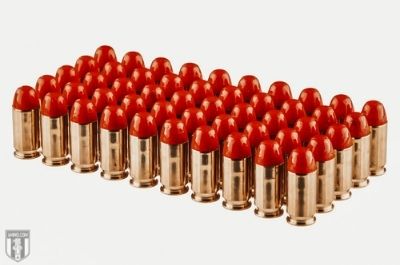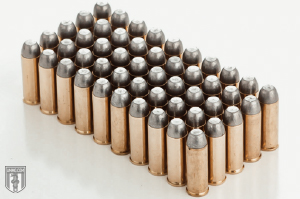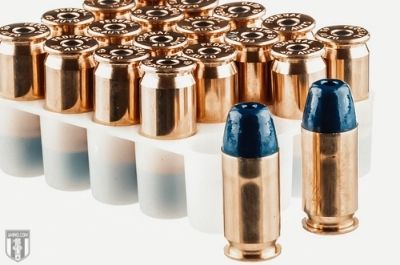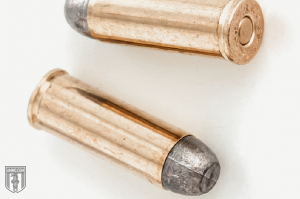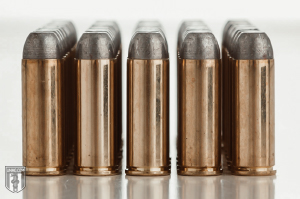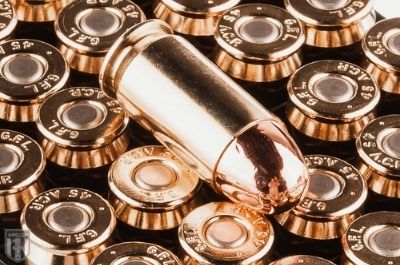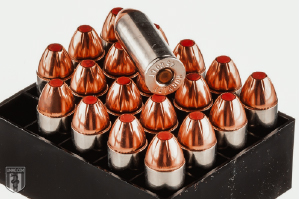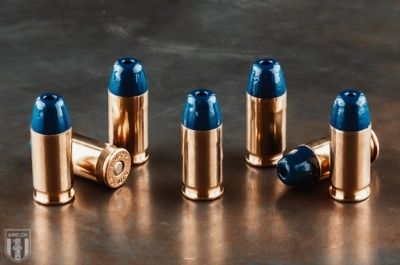45 Colt vs 45 ACP: Battle of the Colt 45’s
 If there were ever two handgun cartridges that could be classified as ubiquitously American, then it would be the 45 Long Colt and the 45 Automatic Colt Pistol (ACP). With a combined service life of over two centuries, both have served as the sidearm cartridge for the U.S. Army and are still used in various applications today in civilian circles.
If there were ever two handgun cartridges that could be classified as ubiquitously American, then it would be the 45 Long Colt and the 45 Automatic Colt Pistol (ACP). With a combined service life of over two centuries, both have served as the sidearm cartridge for the U.S. Army and are still used in various applications today in civilian circles.
Although the 45 Colt and 45 ACP have similar naming conventions, they are not interchangeable and are used in completely different firearms. The 45 LC is predominantly a revolver cartridge while the 45 ACP is used in semi-automatic handguns.
In this article we will compare two of the most iconic 45-caliber handgun cartridges in American history so that you can have a deeper understanding of each and what makes them an excellent choice for your next firearm purchase.
What is The Difference Between 45 Long Colt vs 45 ACP?
The difference between 45 Long Colt and 45 ACP is the case design and the original powder used in each cartridge. The 45 Long Colt is a rimmed revolver round designed to use black powder while the 45 ACP is a rimless cartridge designed for use in semi-automatic pistols with smokeless powder.
Cartridge Specs
When comparing two handgun rounds, it’s a good practice to examine the cartridge specs to gain a better understanding of each.
Perhaps the most obvious difference between the 45 Long Colt (LC or Colt for short) and 45 Auto is their case length. The 45 LC has a case length of 1.285” compared to 0.898” for the 45 ACP. The overall length of the 45 Colt is also longer at 1.6” compared to 1.275” for 45 Auto.
With a longer case, it’s no surprise that the 45 LC has a higher case capacity than the 45 ACP. The 45 LC case can house upwards of 41.6 grains of propellant compared to 26.7 gr for the 45 Auto.
Although the 45 Long Colt can handle over 50% more powder than the 45 ACP, the 45 LC has a lower maximum pressure of 14,000 psi compared to 21,000 psi for 45 ACP as established by SAAMI. This is perhaps one of the biggest differences between the two cartridges: the 45 Colt cartridge was designed to use black powder while the 45 ACP was designed to be fired with smokeless powder.
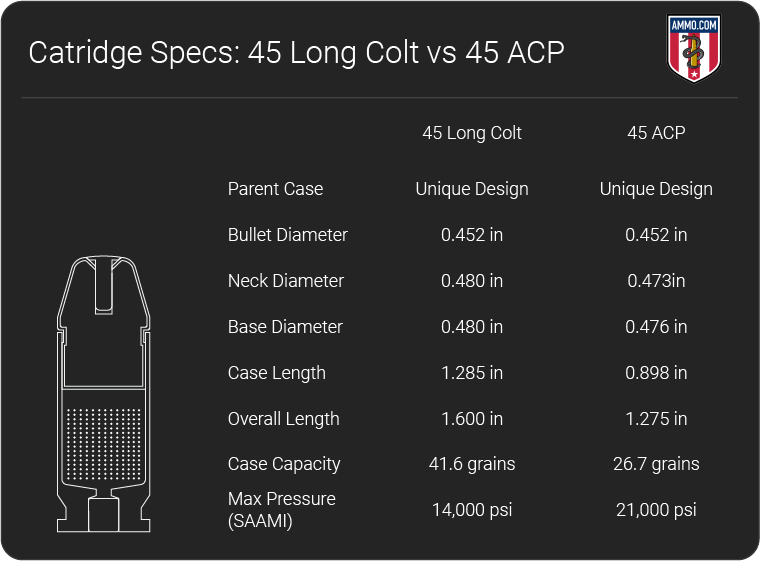
As black powder produces considerably less pressure than modern smokeless powders, extreme caution needs to be observed when using modern 45 Long Colt cartridges in classic revolvers. As these revolvers were not designed to handle the higher pressures modern ammo can produce, a catastrophic failure might result causing damage to the firearm and potentially the shooter.
It should also be noted that the bullet diameter is the same for both cartridges. The cast lead bullet diameter is used in the table above of 0.452”, full metal jacket (fmj) or jacketed hollow point (jhp) bullets will have a diameter of 0.451” for both cartridges.
Although both handgun rounds fire the same diameter bullet, the 45 Long Colt will generally fire heavier bullets as it was designed to fire a 250 gr cast lead bullet while the 45 ACP was developed using the 230 gr fmj bullet in mind.
The 45 Long Colt can fire bullets between 180 and 335 gr, with the 225 and 250 grain bullets being the most popular. In contrast, the 45 ACP can fire bullets between 135 and 250 gr with the 185 and 230 gr options outstripping all other factory loads.
Stopping Power/Kinetic Energy
Stopping power is one of those ubiquitous terms that gets thrown around campfires and gun store counters and is completely unquantifiable. You’ll hear stories of how boutique rounds like the 357 SIG have “More stopping power than a 380 Auto” or how, “The 44 Magnum is a real man stopper.”
The important thing to remember is that shot placement is more important than any ballistics values as a .22LR between the eyes will always be more lethal than a 500 Smith & Wesson Magnum to the hand.
However, we can quantify how many ft-lbs of force is imparted upon the target for each cartridge.
The 45 ACP and 45 LC are very similar in terms of total foot-pounds of energy. There will always be load to load variability, but in general the 45 ACP is slightly more powerful. This is primarily due to its use of smokeless powder and higher pressure limits.
Take for example the 185 gr FTX Critical Defense loads from Hornady, which is used for both 45 ACP and 45 Colt. The 45 ACP round will have 411 ft-lbs of muzzle energy compared to 348 ft-lbs for the 45 Colt round. However, if we compare the 230 gr Remington HTP jacket hollow point ammo, the 45 Auto will have 356 ft-lbs of muzzle energy compared to 369 ft-lbs for 45 Colt.
Although these two examples show the disparity between the two cartridges is slight. Generally speaking the 45 ACP will have slightly more kinetic energy than the 45 Colt.
Recoil
Recoil is an important consideration when purchasing a new self-defense handgun. A round with heavy recoil will be more difficult to control and will slow your rate of follow up shots.
Recoil is affected primarily by muzzle velocity (FPS), bullet weight, and handgun weight. The faster a bullet travels, the harder it pushes back on the shooter. Furthermore, a heavier bullet requires more force to push it out the barrel, which is returned to the shooter’s wrists.
Although the 45 Colt typically fires heavier bullets, felt recoil for 45 LC and 45 ACP ammo is virtually identical. On average, regular 45 Colt ammo will have around 8 ft-lbs of recoil energy compared to 7.5 ft-lbs for the 45 ACP round.
Although there is a slight recoil advantage for the 45 ACP over the 45 LC, this advantage is so minimal that most shooters will not be able to tell the difference between the two.
Velocity/Penetration
Muzzle velocity is very important when it comes to self-defense rounds, as higher velocity typically correlates to deeper penetration into the target. Penetration is important as a bullet must reach and effectively damage the vital organs to incapacitate an attacker.
Muzzle velocity is dependent upon several factors that include but are not limited to barrel length, bullet weight, and powder charge.
As in the other ballistic categories, the 45 ACP has a slight edge over the 45 LC in terms of velocity and penetration.
If we compare the same Hornady 185 gr FTX Critical Defense loads mentioned above, the 45 ACP has a muzzle velocity of 1,000 fps compared to 920 fps for the 45 Colt.
Again, this is not a massive difference, and you will get adequate penetration from both handgun rounds. However, the 45 ACP does have a slight edge over the 45 LC in this category.
Magazine Capacity
The 45 ACP is the clear winner when it comes to magazine capacity.
As the 45 Colt is a revolver round, its capacity is 6 or less depending on the handgun.
Magazine capacity for the 45 ACP depends primarily on the firearm. For a 1911 most magazines are 7 or 8 rounds, for a modern semi-auto like a Glock 21 you will have 13 rounds in the magazine or more.
There simply is no comparison between a revolver and a semi-automatic handgun when it comes to magazine capacity.
Hunting
Hunting is one area where the 45 Long Colt outshines its semi-auto counterpart.
As the 45 Colt can be used in a lever-action rifle as well as a revolver, it is the better option as a hunting round. Its large case capacity combined with modern firearms allows the 45 Long Colt to achieve considerably higher muzzle velocity and muzzle energy than the 45 ACP.
That last statement might seem like a bit of a contradiction to the astute reader, so let me explain.
Although the original design for the 45 Long Colt called for the use of black powder, this has not stopped ammo manufacturers from pushing the limits of the cartridge using smokeless powder.
These hotter, 45 Colt +P loads put it on par with the 44 Magnum in terms of muzzle velocity and energy and can only be used in revolvers rated to handle the higher pressure that smokeless powder creates.
The two handguns that can handle 45 Colt +P factory loads are the Ruger Blackhawk and the Thompson/Center Contender. All other 45 Long Colt handguns are NOT rated for +P ammo unless explicitly stated by the manufacturer. When in doubt, seek the services of the manufacturer or a profession gunsmith to determine the correct ammo to use in your firearm.
To put this into perspective, the 45 Colt +P firing a 300 gr Hornady XTP hollow point can attain a muzzle energy of 1,126 ft-lbs traveling at 1,300 fps. Compare that to a 44 Magnum firing a 240 grain bullet at 940 ft-lbs of energy or a 357 Magnum firing a 158 grain bullet at 550 ft-lbs of energy.
Clearly the 45 Long Colt round can be an extremely potent hunting cartridge as it can outstrip the 357 and 44 Magnum in terms of ballistic performance. Only revolver rounds like the 454 Casull or 500 Smith & Wesson Magnum can outpace the 45 LC in terms of hunting performance.
Hunting with a lever-action rifle is always nostalgic and would make an excellent option for whitetail deer or smaller game animals.
The 45 ACP is not a hunting round as it lacks kinetic energy for medium sized game and does not have the trajectory for long range shots.
If you want to hunt, the 45 Long Colt is the obvious choice.
Make sure to stock up on your ammo before hunting. Check out our Fiocchi 45 Colt ammo page for more ammo options.
Concealed Carry/Home Defense
As the 45 ACP was designed for use in semi-automatic pistols, it is the better choice for self-defense.
Since the 45 Auto and 45 Colt have similar terminal ballistics, the primary difference between them in terms of self-defense is reload speed and magazine capacity.
And a semi-automatic pistol will almost always be superior to a revolver in these two categories.
This is not to say that a revolver cannot defend your life or home should your life be threatened. On the contrary, a revolver is an extremely effective personal defense tool and should not be underestimated.
However, when it comes to surviving a self-defense situation, typically the person who brings more ammo comes out on top. Therefore, being able to reload quickly and carry more bullets in a personal defense encounter will always be preferable.
Reload speed on a revolver can be overcome with consistent and proper training. Moon clips and speed loaders help with this and revolver users can become extremely quick with their reloads. However, most shooters will find it simpler to train and easier to carry additional magazines for their semi-automatic pistols.
From a concealed carry standpoint, a 45 ACP pistol will generally be easier to conceal than a 45 Colt revolver. A Colt .45 Officer’s 1911 or a Glock 36 will be considerably thinner than any revolver chambered in 45 LC, making them easier to carry and conceal without major wardrobe considerations.
For self-defense, the most important thing is to carry what you shoot best. It doesn’t matter how fast you can reload if you can’t hit the broad side of a barn. However, most shooters prefer the speed of a semi-auto and this favors the 45 ACP.
Ammo and Handgun Cost/Availability
When it comes to ammo cost and availability, the 45 ACP is clearly the superior choice.
As far as variety is concerned, the 45 Auto holds around a 2:1 advantage over the 45 Colt. This advantage is due to the 45 ACP being a military cartridge for nearly 80 years. As it grew in popularity among law enforcement and civilian shooting circles, more manufacturers started offering 45 ACP factory loads.
It’s true that the 45 LC was a military cartridge as well, but its lifespan was considerably shorter than the 45 ACP. Today, the 45 Colt is primarily used by cowboy action competitors and recreational shooters who enjoy the nostalgia of an older cartridge.
Popularity and high demand typically bring lower prices, and the 45 ACP is generally less expensive than the 45 LC.
Inexpensive fmj practice ammo will generally run around $0.60/round while self-defense ammo starts around $1.40/round for 45 ACP. However, as the 45 Colt is less popular, hard cast lead practice round start at $1/round while self-defense ammo begins at $1.70/round and goes up quickly from there.
Another advantage is that 45 Auto pistols are relatively plentiful and easy to come by, whereas 45 Colt revolvers are generally more expensive and rarer to find on the open market. From a cost standpoint, a Glock 21 in 45 ACP can be had for about 1/4 the price of a Colt Single Action Army revolver (SAA) in 45 LC.
The widespread popularity of the 45 ACP cartridge has encouraged an increase in production by numerous manufacturers, both of ammunition and firearms specifically tailored for it. For instance, Blazer Brass 45 ACP is a notable example of ammunition tailored to meet the demands of enthusiasts and professionals alike.
Reloading
When it comes to reloading, making handloads for both the 45 ACP and 45 Colt makes a lot of sense.
Both are straight-walled pistol cartridges, which makes them extremely simple to resize.
Furthermore, they both use the same diameter projectiles, so it is easier to stockpile bullets for both cartridges while buying in bulk. There is also a lot of overlap when it comes to powder choices that can be used for both handgun cartridges, making it simpler to purchase powder in bulk.
However, special care needs to be taken when loading 45 LC with smokeless powder. Given the massive case capacity, it would be easy to accidentally double charge a case. This is generally a concern for revolver cartridges as they have more case capacity than they need for smokeless powder loads. This presents a dangerous situation where one of your handloads could damage your firearm and/or yourself.
Make a habit of always checking your revolver cases before you seat the bullet to ensure you’ve not double charged a case. This extra step could mean the difference between an enjoyable trip to the range and never opening pickle jars again.
Both the 45 ACP and 45 LC are a joy to reload and a great way to reduce your overall cost per round.
Buying in bulk is always smart, make sure to check out our stock of bulk 45 ACP ammo.
Ballistics: 45 Long Colt vs 45 ACP
Our team here at Ammo.com has spent countless hours scouring the Internet to bring you extremely comprehensive ballistics tables for both calibers. These tables will compare bullet weight to muzzle velocity, kinetic energy, and trajectory.
.45 Colt Ballistics
When it comes to firing a firearm chambered for the .45 Long Colt, the shooter can expect a cartridge that provides efficiency and accuracy, as well as some significant knockdown power. As for the .45 Colt ballistics, a range of performance can be expected depending on the type and style of ammunition used.
Note: This information comes from the manufacturer and is for informational purposes only. The actual ballistics obtained with your firearm can vary considerably from the advertised ballistics. Also, ballistics can vary from lot to lot with the same brand and type load.
| 45 Long Colt Bullet WEIGHT | Muzzle VELOCITY (fps) | Muzzle ENERGY (ft. lbs.) | Mid-Range TRAJECTORY (in.) | Barrel Length (in.) | |||||
|---|---|---|---|---|---|---|---|---|---|
| Muzzle | 50 yds. | 100 yds. | Muzzle | 50 yds. | 100 yds. | 50 yds. | 100 yds. | ||
| 180 Grain | 730 | n/a | n/a | 213 | n/a | n/a | n/a | n/a | n/a |
| 180 Grain FTX | 920 | 870 | 826 | 348 | 311 | 280 | n/a | n/a | 3-V |
| 200 Grain | 1000 | 938 | 889 | 444 | 391 | 351 | 1.3 | 4.8 | 5.5" |
| 225 Grain | 960 | 890 | 830 | 460 | 395 | 345 | 1.3 | 5.5 | 5.5" |
| 230 Grain | 730 | n/a | n/a | 272 | n/a | n/a | n/a | n/a | n/a |
| 250 Grain | 860 | 820 | 780 | 410 | 375 | 340 | 1.6 | 6.6 | 5.5" |
| 255 Grain | 860 | 820 | 780 | 410 | 375 | 340 | 1.6 | 6.6 | 5.5" |
| 300 Grain +P | 1300 | 1197 | 1114 | 1126 | 956 | 827 | 2.78 | 0 | n/a |
.45 ACP Ballistics
Note: This information comes from the manufacturer and is for informational purposes only. The actual ballistics obtained with your firearm can vary considerably from the advertised ballistics. Also, ballistics can vary from lot to lot with the same brand and type load.
| 45 Auto (ACP) Bullet WEIGHT | Muzzle VELOCITY (fps) | Muzzle ENERGY (ft. lbs.) | Mid-Range TRAJECTORY (in.) | Barrel Length (in.) | |||||
|---|---|---|---|---|---|---|---|---|---|
| Muzzle | 50 yds. | 100 yds. | Muzzle | 50 yds. | 100 yds. | 50 yds. | 100 yds. | ||
| 150 Grain | 1050 | n/a | n/a | 403 | n/a | n/a | n/a | n/a | n/a |
| 165 Grain | 1030 | 930 | n/a | 385 | 315 | n/a | 1.2 | n/a | 5" |
| 165 Grain Guard Dog | 1140 | 1030 | 950 | 475 | 390 | 335 | n/a | n/a | 5" |
| 185 Grain | 1000 | 940 | 890 | 410 | 360 | 325 | 1.1 | 4.9 | 5" |
| 185 Grain Match | 770 | 705 | 650 | 245 | 204 | 175 | 2 | 8.7 | 5" |
| 200 Grain | 940 | 890 | 840 | 392 | 352 | 312 | 2 | 8.6 | 5" |
| 200 Grain | 975 | 917 | 860 | 421 | 372 | 328 | 1.4 | 5 | 5" |
| 230 Grain | 830 | 800 | 675 | 355 | 325 | 300 | 1.6 | 6.8 | 5" |
| 230 Grain | 880 | 846 | 816 | 396 | 366 | 340 | 1.5 | 6.1 | 5" |
| 165 Grain +P | 1250 | n/a | n/a | 573 | n/a | n/a | n/a | n/a | n/a |
| 185 Grain +P | 1140 | 1040 | 970 | 535 | 445 | 385 | 0.9 | 4 | 5" |
| 200 Grain +P | 1055 | 982 | 925 | 494 | 428 | 380 | n/a | n/a | 5" |
.45 Colt Development and History
Development of the .45 Colt revolver began in 1871 as a joint effort between Colt and Union Metallic Cartridge Company (UMC). The Colt Single Action Army revolver (SAA) was submitted for approval to the U.S. Army in late 1872 and was accepted in 1873.
Ammunition development did not begin until 1872, and the new 45 Colt cartridge (also referred to as Long Colt or LC) was unveiled with its groundbreaking revolver at the same time.
The 45 Long Colt was a huge leap forward in cartridge technology for its time, as it utilized an internally lubricated bullet which did not pick up dirt and grime like its predecessors. Developed to be used with black powder, the original load called for a 40 grain powder charge topped with a 255 gr flat nosed lead bullet fired at 1,050 fps.
The original load for the 45 Colt was extremely powerful for its time, so much so that many soldiers could not handle the heavy recoil that the new round produced. Several years later, reduced power loads were introduced using a 26 gr black powder charge pushing the same 255 gr bullet at 855 fps. This load was used in military service alongside the 45 Smith & Wesson Schofield round for 14 years before being replaced by the .38 Long Colt in 1892.
The 45 LC saw widespread success in the civilian market during the days of the Wild West. The Colt SAA, or Peacemaker as it was called, was one of the preferred revolvers of ranchers, bandits, and lawmen such as Wyatt Earp.
Although the 45 Colt never saw the widespread success of the semi-auto 45 ACP, the 45 LC has begun to see a resurgence in use with the release of combination 45 Colt/410 shotgun shell revolvers such as the Taurus Judge or Smith & Wesson Governor.
Additionally, cowboy action shooters still love their 45 LC revolvers as Colt, Ruger, Uberti, and Cimarron still produce time appropriate revolvers for these competitions.
Modern hunting 45 Colt ammo designed for the heavier framed Ruger Blackhawk, Ruger Redhawk, and T/C Contender rival the ballistic performance of the 44 Magnum and liken back to the original 45 LC loads fielded by the military in the 1870’s.
Even though the 45 Long Colt is an outdated design by modern standards, it is still loved by many who enjoy classic firearms or just love shooting a big bore caliber in a wheel gun!
45 ACP Development and History
The 45 ACP (Automatic Colt Pistol) was developed by the renowned American firearms inventor, John Moses Browning, in 1904. The 45 ACP was an innovation, as many are, birthed from necessity.
During the Philippine-American War, the US Cavalry became displeased with the lack of stopping power provided by their .38 Long Colt sidearms. The US military concluded that bigger bullets with more stopping power were required, and that the ideal caliber for this duty was .45 due, in part, to the success of the 45 Long Colt.
Prior to this development, John Browning had been working in tandem with Colt to develop a new 41 caliber for consideration. However, when this new order came from the US Military, Colt and Browning increased the caliber to .45.
Initially the new 45 ACP cartridge was designed to fire a 200-grain bullet at 900 fps. However, after some modifications by the Frankford Arsenal, Union Metallic Cartridge, and Winchester, the finalized version was adorned with a 230-grain full metal jacket (FMJ) fired at 850 fps.
The final version of the 45 ACP mimicked the ballistic performance of the 45 Schofield and the 45 Long Colt but was significantly shorter.
In 1906, Colt (using John Browning’s design) and 5 other firearms manufacturers submitted handguns for consideration. Only Colt and Savage Arms made the final cut in 1910.
The resulting testing run by the US Military showed the Colt submission experiencing zero failures while the Savage sidearm had 37 stoppages. The Colt handgun was selected as the Model 1911.
The Colt 1911 and the 45 ACP served in all branches of the US Military for the next 70+ years as the standard issue sidearm and ammo. It carried us through World War I and II, the Korean War, and Vietnam. It was not until the 1980s that the military decided to update their service pistol and opted to move towards the Beretta M9 and the 9mm Luger cartridge.
The 45 ACP is well known in the shooting community for its stopping power, accuracy, and reliability.
In general, the 45 ACP is a low-pressure round with SAAMI specs citing a maximum pressure of 21,000 psi (considerably less than 35,000 psi for 9mm). It is naturally subsonic, which makes it ideal for use with a suppressor/silencer or submachineguns.
Your standard, off-the-shelf 230 grain full metal jacket (FMJ) Winchester ammo will have a muzzle velocity of 835 fps and muzzle energy of 356 foot-pounds of force.
The 45 ACP is truly America’s Cartridge and it has a huge following both in military, law enforcement, and civilian shooting circles across the USA.
If you’d like to learn more about how the 45 ACP compares to other calibers, check out these articles below:
Final Shots: 45 Colt vs 45 ACP
Although the 45 Colt and 45 ACP are extremely similar in terms of ballistic performance, the real question you need to ask yourself about these two cartridges is: Revolver or Semi-Automatic?
Making that decision will invariably lead you to the correct choice when it comes to 45 Colt vs 45 ACP.
Though somewhat dated, the 45 LC has a classic feel about it that so many other Wild West cartridges aspire towards. Though the 44-40 and 38-40 might be all the rage at the local Cowboy Action Shooting competition, none of them command the name recognition and allure of the classic 45 Colt and the Single Action Army revolver. There’s a mystique about it that cannot be replicated by any modern cartridge, and that has helped it endure for well over a century.
The 45 ACP is the most prolific 45-caliber handgun cartridge on the market and has carried the U.S. military through both world wars. It is a powerful round that cut its teeth on the beaches of Normandy and in the jungles of Vietnam. It’s a lower pressure round compared to modern 9mm Luger and 40 S&W, but the 45 ACP commands respect as an extremely potent self-defense round and protector of liberty.
The decision between these two iconic 45’s comes down to which handgun you prefer and shoot best.
And to ensure that you have enough ammo for proper training, make sure you get all your 45 ACP or 45 LC here at Ammo.com. I’ll see you out on the range!
Ammo Comparisons
- .308 vs 5.56
- 6.5 Creedmoor vs .308
- .300 Blackout vs .308
- .300 Win Mag vs .308
- .243 vs .308
- .308 vs .30-06
- 7mm-08 vs .308
- .270 vs .308
- 7.62x39 vs .308
- .223 vs .308
- .338 Lapua vs .308
- .380 ACP vs 9mm
- .223 vs 5.56
- .300 Blackout vs 5.56
- 9mm vs 45 ACP
- 9mm vs 40 S&W
- .357 SIG vs 9mm
- 10mm vs 9mm
- 9mm vs 9mm Luger
- .243 vs .270
- .300 Win Mag vs .30-06
- .270 vs .30-06
- .40 vs .45
- 38 Special vs 357
- 9mm vs 40 vs 45
- 5.56 vs 7.62x39
- 338 Lapua vs .30-06
- .30-30 vs .30-06
- 300 PRC vs 338 Lapua
- .30-06 vs 7mm
- 300 Win Mag vs 338 Lapua
- 300 PRC vs 300 Win Mag
- 300 WSM vs 300 Win Mag
- 338 Win Mag vs 338 Lapua
- 12 Gauge vs 20 Gauge
- 10mm vs 357 Mag
- .30-30 vs 7.62x39
- 224 Valkyrie vs 22-250
- 17 HMR vs 22 Mag
- 7.62x39 vs .300 Blackout
- 45 ACP vs 45 Auto
- 45-70 vs 30-30
- 300 Blackout vs 223
- 357 Magnum vs 9mm
- 350 Legend vs 300 Blackout
- 224 Valkyrie vs 223
- 45 ACP vs 38 Super
- 6.5 Grendel vs .308
- 17 HMR vs 22 LR
- 10 Gauge vs 12 Gauge
- 22-250 vs 223
- 45 Colt vs 45 ACP
- 350 Legend vs 30-30
- 5.7x28 vs 223
- 5.7 vs 9mm
- 5.56 vs 5.7
- 22 vs 9mm
- Buckshot vs Birdshot
- 450 Bushmaster vs 308
- 450 Bushmaster vs 223
- Buckshot vs Slug
- 6.5 Grendel vs 5.56 vs 223
- 6mm ARC vs 6.5 Grendel
- 44 vs 45
- 458 SOCOM vs 5.56
- 357 vs 44
- 32 ACP vs 380
- 300 Win Mag vs 338 Win Mag vs 338 Lapua Mag
- 450 Bushmaster vs 458 SOCOM vs 50 Beowulf
- 6mm Creedmoor vs 6.5 Creedmoor
- TMJ vs FMJ
- 44 Special Vs 44 Magnum
- 45 90 vs 45 70
- 6.8 Western vs 6.8 SPC
- 50 Beowulf vs 50 BMG
- 26 Nosler vs 6.5 PRC
- 28 Gauge vs 410
- 6.8 SPC vs 5.56
- 6.8 SPC vs 6.5 Grendel
- 6.8 Western vs 7mm Rem Mag vs .28 Nosler
- 6.8 Western vs 6.5 Creedmoor
- 22 Hornet vs 223
- 6.8 Western vs 6.5 PRC
- .410 vs 12 Gauge
- .410 vs 20 Gauge
- 22 LR vs 22 Mag
- 6mm ARC vs 243
- 7mm-08 vs 270
- 243 vs 6.5 Creedmoor
- Nickel vs Brass Casing
- 204 Ruger vs 223
- 50 Beowulf vs 5.56
- 260 Remington vs 6.5 Creedmoor
- 6mm Remington vs 243
- 28 Nosler vs 300 PRC
- 50 Beowulf vs 50 AE
- 22 Nosler vs 22-250
- 450 Marlin vs 45-70
- 300 Win Mag vs 300 Norma
- 458 SOCOM vs 300 Blackout
- 38-55 vs 45-70
- 22 Hornet vs 22 LR
- 300 Norma vs 338 Lapua
- 338 Lapua vs 50 BMG
- 28 Nosler vs 300 Win Mag
- 28 Nosler vs 6.5 Creedmoor
- 204 vs 22-250
- 458 SOCOM vs 45 70
- 44 40 vs 45 70
- 6.8 SPC vs 6.5 Creedmoor
- 450 Bushmaster vs 30-06
- 7mm Rem Mag vs 300 Win Mag
- 30 Carbine vs 223
- 25-06 vs 30-06
- 26 Nosler vs 28 Nosler
- 16ga vs 12ga
- 30 06 vs 7.62 x54R
- 9mm Makarov vs 9mm Luger
- 350 Legend vs 223
- 30 Carbine vs 5.56
- 6.5x55 vs 6.5 Creedmoor
- 6.5 Creedmoor vs 270 vs 25-06
- M193 vs M855
- 450 Bushmaster vs 458 SOCOM
- 6.5 Grendel vs 6.5 Creedmoor
- 350 Legend vs 5.56
- .277 Fury vs 6.8 SPC
- 277 Fury vs 300 Win Mag
- 10mm vs .45 ACP
- 277 Fury vs 223
- 6.8 SPC vs 300 Blackout
- 6.5 PRC vs 6.5 Creedmoor
- 277 Fury vs 308
- 277 Fury vs 6.5 Creedmoor
- 350 Legend vs 450 Bushmaster
- 277 Fury Vs 5.56 NATO
- 10mm vs 40S&W
- 32 ACP vs 9mm
- 32 Special vs 9mm
- 8.6 Blackout vs 300 Blackout
- 30 Super Carry vs. 9mm
- 5.56 vs 9mm
- .50 Action Express vs 9mm
- 7.62x25 vs. 9mm
- 10mm vs 44 Magnum
- 300 Blackout vs 300 Win Mag
- 6.5 Grendel vs 300 Blackout
- 460 Rowland vs 10mm
- 300 RUM vs 300 PRC
- 300 Norma vs 300 PRC
- 45 GAP vs 45 ACP
- 7mm PRC vs 300 Win Mag
- 300 PRC vs 6.5 Creedmoor
- 300 PRC vs 308
- 357 SIG vs 357 Mag
- 7.62x39 vs 7.62x51
- 243 Win vs 223 Rem
